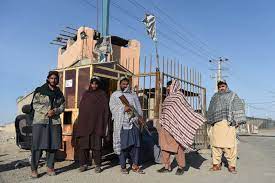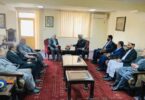WASHINGTON (Arabnews): Recent border tensions between Iran and the Taliban government in Afghanistan have resulted in the death of several military personnel from both sides and exposed deep historic and recent fissures between the two nations.
Though both governments have taken measures to quickly de-escalate tensions, the risk of war or wider conflict between the countries remains plausible, according to experts who spoke during a session organized by the Middle East Institute in Washington and attended by Arab News on Friday.
Experts said that there are deep-rooted obstacles or sources of tension which may ebb and flow in the future.
These sources of tension include border demarcation between the two countries; water that flows from the Helmand River from Afghanistan into Iran; Iran’s failure to formally recognize the Taliban government; and the Taliban’s anti-Iran stance.
Fatemeh Aman, who is an expert on the two countries and a non-resident senior fellow at the MEI, said that “Iran had never cut its ties with the Taliban,” and added that Iran had supported the Islamic movement with weapons in an attempt to expand its influence and counter the US presence in the region during the American military occupation of Afghanistan.
She added: “The policies of Iran toward Afghanistan have not changed under any government that has come to power in the years since the Iranian Revolution in 1979.”
Aman argued that Iran — despite the water flow issue — is aware that a possible conflict with Afghanistan would not provide an easy victory.
She said that regional “spoilers” would also find a way to engage against Iran should some kind of military conflict take place.
Nilofar Sakhi, a non-resident senior fellow at the Atlantic Council, said that Iran had three strategic and thematic interests in Afghanistan: economic expansion, security, and the Shiite-Sunni divide.
She added that Iran wants Afghanistan to be a connector to the markets in Central Asia and a market for its own products, and that Iran does not want violence and instability in Afghanistan to spill over to its side of the border.
Sakhi argued that Iran lacked influence and understanding of the Taliban’s internal structures, adding that it was essentially blind when it came to contemplating its deeper dynamics.
However, she argued that Iranian policymakers reasoned that an engagement with the Taliban was in their best interests, and doing so would ensure it was not left behind in the region.
Alex Vatanka, who moderated the session and is the director of the Iran Program at the MEI, said that Iran had been essentially negligent in dealing with Afghanistan, a country that sits on its borders and has been unstable for years.
He added: “You would think that Iran would invest more energy trying to figure out what’s going on in Afghanistan, yet they are busy elsewhere in the Arab world.”
He said that the Taliban were eager to tone down tensions to show the world they can be good neighbors, while seeking recognition and financial assistance from the international community.
Andrew Watkins, a senior expert on Afghanistan at the US Institute of Peace, said that although the water issue predated current governments, it was a seasonal issue as the Taliban allowed the flow to increase into Iran in the winter but reduced it during summer months.
He added: “In some ways climate change is the real factor here, much more than the behavior of Iran or the Taliban.”
Iran and Afghanistan signed the Helmand River Water Treaty to address the issue in 1973. It remains the only agreement to specifically address the water allocation from Afghan territories into Iran.







